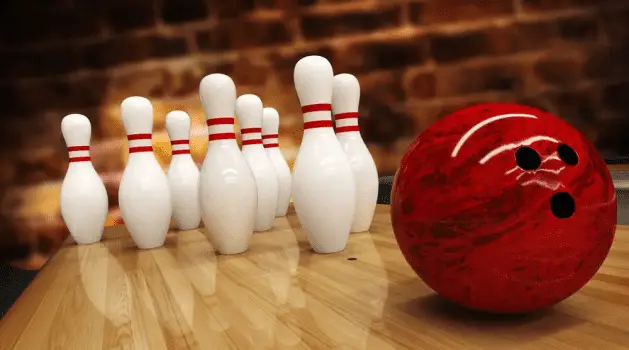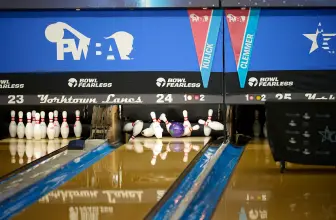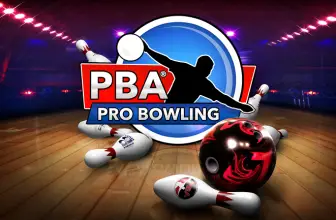Want to skip ahead to a particular section?
Introduction
Bowling is a fun and exciting game that can be enjoyed by people of all ages and skill levels. Whether you’re a beginner or a seasoned pro, these expert bowling tips can help improve your game and make your bowling experience more enjoyable. In this article, we will discuss some of the best bowling tips for bowlers, including basic techniques, choosing the right ball, and common mistakes to avoid.
General Bowling Tips
Choosing the right bowling ball
When it comes to bowling, selecting the perfect ball is crucial. It’s not just about picking a ball that looks cool or has a catchy name; it’s about finding one that fits your hand and your style of play. A ball that is too heavy or too light can greatly impact your accuracy and overall performance.
The first step in choosing the right bowling ball is to determine the weight that works best for you. A ball that is too heavy can cause fatigue and strain on your arm, while a ball that is too light may not give you enough control over your throw. Take the time to find a ball that feels comfortable in your hand and allows you to maintain proper form throughout your approach.

Another important factor to consider when selecting a bowling ball is the coverstock. This refers to the outer layer of the ball and can greatly affect its performance in different lane conditions. For example, a ball with a smooth coverstock may work well on a dry lane, while a ball with a rougher surface may be better suited for a lane with more oil.
It’s also important to consider the ball’s core, which can greatly impact its hook potential and overall reaction on the lane. Different cores can provide varying levels of control and power, so it’s important to choose one that works well with your style of play.
When it comes down to it, selecting the right bowling ball is all about finding one that feels comfortable and allows you to perform at your best. Don’t be afraid to try out different balls and experiment with different weights, coverstocks, and cores until you find the perfect match for your game. With the right ball in hand, you’ll be well on your way to improving your skills and achieving success on the lanes.
How to grip the ball properly
The grip is one of the most important aspects of your bowling technique. It’s important to find a grip that’s comfortable for you and allows you to control the ball. Many bowlers prefer the conventional grip, where the fingers are inserted up to the second knuckle and the thumb goes all the way in. Others prefer the fingertip grip, where the fingers only go in up to the first knuckle and the thumb goes all the way in.
Properly gripping the bowling ball is essential to achieving accuracy and control in your throw. Start by placing your fingers into the holes of the ball, making sure they fit snugly without being too tight or too loose. Your thumb should also fit comfortably in its hole, with no excess space or pressure.

Next, focus on your grip pressure. You want to grip the ball firmly, but not so tight that you lose flexibility in your wrist and fingers. A good way to test your grip pressure is to hold the ball at waist height and try shaking it loose – if it falls out easily, you may need to tighten your grip, while if it’s difficult to shake loose, you may be gripping too tightly.
Finally, make sure your wrist is positioned correctly. Your wrist should be straight, with no bending or twisting, and your fingers should be positioned slightly to the side of the ball for maximum control. With practice and attention to detail, you can master the proper grip and take your bowling game to the next level.
How to execute the perfect throw
Executing the perfect throw requires a combination of factors, including your approach, release, and follow-through. It’s important to maintain a consistent approach and release, as well as follow through with your arm and body to ensure accuracy and power. It takes practice to perfect your throw, but with the right bowling tips and guidance, you can improve your technique and see better results on the lanes.

To execute the perfect throw in bowling, it all starts with the proper grip. Make sure your fingers fit snugly in the holes and your thumb is comfortable. Your grip pressure should be firm but not too tight, and your wrist should be straight with no bending or twisting. Position your fingers slightly to the side of the ball for maximum control. With practice and attention to detail, you’ll be able to achieve accuracy and control in your throw and take your bowling game to new heights.
Tips for Beginners
Basic elements of the throwing technique
If you’re a beginner, it’s important to start with the basics. The three main elements of a good throw are the approach, the release, and the follow-through. Start with a smooth, consistent approach, and then release the ball with a firm, but not tight grip. Finally, follow through with a smooth, straight arm motion to ensure accuracy.
- Stand with your feet shoulder-width apart, with your non-dominant foot slightly forward. Keep your knees slightly bent and your weight evenly distributed.
- Hold the ball with both hands, keeping your fingers spread wide and your wrist straight. Your dominant hand should be on top of the ball, with your non-dominant hand supporting from below.
- Take a few small steps back from the foul line to build momentum for your throw.
- Take a few larger steps forward, leading with your non-dominant foot, to release the ball at the foul line.
- Release the ball with a smooth motion, keeping your wrist straight and your fingers pointing toward your target.
- Follow through with your arm, extending it towards your target after releasing the ball. This will help you maintain accuracy and power in your throw.
- Regular practice is key to improving your technique and becoming a better bowler. Try to practice at least once a week, if possible.
How to improve your bowling game
Improving your bowling game takes time and practice. One important tip is to work on your accuracy. Focus on hitting the same spot on the lane every time you throw the ball. You can also work on your speed and power by practicing your footwork and arm swing. And don’t forget to work on your mental game, too. Stay focused, stay positive, and believe in yourself.
Common mistakes to avoid
There are several common mistakes that beginners make when they start bowling. One is gripping the ball too tightly. This can lead to a lack of control and accuracy. Another mistake is rushing the approach, which can throw off your timing and lead to a poor throw. Finally, beginners often make the mistake of not following through properly. Remember to keep your arm straight and follow through with a smooth, controlled motion.
Some beginner bowlers may:
- hold the ball too tightly or too loosely, which can lead to an unsuccessful throw. Make sure you are holding the ball correctly by spreading your fingers and keeping your wrist straight.
- release the ball too early, not following through to the end. This can result in a loss of accuracy and power in the throw. Make sure you follow through to the end, extending your arm toward the target after releasing the ball.
- not pay attention to their stance and not evenly distribute their weight. This can lead to an unsuccessful throw and even injuries. Make sure you stand comfortably and evenly distribute your weight on both feet.
- not practice regularly, which can make it difficult to improve their skills. Regular practice is key to success in bowling.
- not watch the ball after throwing it, which can lead to a loss of accuracy and power in subsequent throws. Make sure you watch the ball after throwing it and analyze your mistakes to improve your technique.
By mastering these basic elements of the throwing technique and practicing regularly, beginners can improve their skills and enjoy the game of bowling even more.
Tips for Seniors
How to maintain physical fitness for bowling
Maintaining physical fitness for bowling is essential for seniors to enjoy the game and avoid injury. Incorporating exercises that focus on balance, strength, and flexibility is key. Yoga, walking, and light weightlifting are all great options.

Maintaining physical fitness is crucial for any sport, including bowling. Here are some bowling tips on how to stay fit for bowling:
- Stretching: Before starting your game, it’s essential to stretch your muscles to prevent injury. Focus on stretching your arms, shoulders, back, and legs.
- Cardiovascular exercise: Cardiovascular exercise helps improve your endurance and stamina, which is crucial for bowling. Activities such as walking, running, cycling, or swimming are excellent options.
- Strength training: Strength training helps build muscle and improve your overall strength, which is essential for throwing the ball accurately. Focus on exercises that target your arms, shoulders, back, and legs.
- Flexibility training: Flexibility training helps improve your range of motion, which is crucial for executing the perfect throw. Yoga or Pilates are excellent options for improving flexibility.
- Proper nutrition: Eating a balanced diet is essential for maintaining physical fitness. Focus on consuming lean protein, whole grains, fruits, and vegetables to ensure you have the energy needed to bowl at your best.
Choosing the right ball based on your physical condition
Choosing the right ball is also important for seniors. Consider a lighter ball if you have trouble with strength or mobility. Additionally, balls with a softer coverstock can help with control and accuracy.
Choosing the right bowling ball for elderly people should be based on their physical condition. Here are some bowling tips to help you choose the appropriate ball:
- Ball weight: The ball should be light and comfortable for elderly people. It is recommended to choose balls weighing between 10 and 14 pounds.
- Hole size: The finger holes should be large enough for elderly people to easily grip the ball and make throws without strain.
- Ball material: Balls made of polyurethane or rubber are the best choice for elderly people as they provide good grip and control.
- Surface type: For elderly people, it is recommended to choose balls with a matte surface as they provide better control and stability.
- Consultation with a professional: If you are unsure about choosing a ball, consult a professional at a sports store or a bowling coach to get recommendations and advice.
Adapting your throwing technique
Adapting your throwing technique can make a big difference in your game. Seniors may benefit from a slower, more controlled throw to reduce strain on the body. Experiment with different approaches and find what works best for you.

In addition to choosing the right bowling ball, seniors may also need to adapt their throwing technique to accommodate their physical condition. Here are some bowling tips:
- Use a lighter ball: As mentioned earlier, using a lighter ball can reduce strain and make it easier to throw accurately.
- Use a shorter approach: Seniors may find it easier to use a shorter approach to the foul line, which can reduce the risk of losing balance or falling.
- Use a slower approach: A slower approach can also help seniors maintain balance and control during the throw.
- Use a lower backswing: A lower backswing can reduce the strain on the shoulder and elbow joints, making it easier for seniors to throw without pain or discomfort.
- Practice regularly: Regular practice can help seniors improve their technique and maintain their physical fitness.
By following these bowling tips and adapting their throwing technique, seniors can continue to enjoy the game of bowling and stay active and healthy.
Tips for Left-Handed Bowlers
As a left-handed bowler, it’s important to make some adjustments to your stance to achieve better accuracy. Start by positioning your left foot slightly to the right of the approach, and your right foot slightly to the left. This will help you create a straight path to the pins without having to angle your body too much. Keep your shoulders square and your arm straight as you release the ball, and aim for the pocket on the right side of the lane.
Another key factor in left handed bowling is knowing how to play on different oil patterns. Depending on the lane conditions, you may need to adjust your speed, angle, and release to get the best results. For example, on a dry lane with little oil, you’ll want to throw a straight ball with a minimal hook. On a heavily-oiled lane, you’ll need to use more hooks and adjust your starting position accordingly.
Finally, choosing the right ball is crucial for left handed bowlers. Look for a ball that has a high RG (radius of gyration) and low differential, which will help it maintain its energy as it rolls down the lane. You may also want to consider a ball with a matte finish rather than a shiny one, as this will provide more traction on oily lanes. With the right ball and some practice, you’ll be able to master the art of left-handed bowling and achieve greater success on the lanes.
Conclusion
Improving your bowling game takes time, practice, and dedication. By following these expert bowling tips, you can develop your skills and become a better bowler. Remember to choose the right ball for your skill level, focus on your technique, and avoid common mistakes. With time and practice, you can master the art of bowling and enjoy hours of fun at the bowling alley lanes. So, start practicing and see the improvement in your game!







Everything is very open and very clear explanation of issues. was truly information. Your website is very useful. Thanks for sharing.
Thanks for helping me understand that we need to choose a light ball for the seniors or anyone who has issues with their strength and mobility to be able to control and be accurate with them. I will keep that in mind when my family joins a bowling club here in Redhead, because we have never tried that activity before. And my dad is actually a senior now, it will be safer for him to choose the right balls to throw to prevent him from getting off balance or injuring himself.